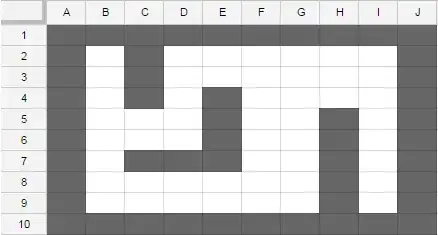I have a rectangular grid of square tiles, some of which are blocked/filled. I start at a random tile inside the grid with the blocked tiles, randomly placed. I can turn in 90° steps and check whether I can enter the tile in front of me, which is possible if the tile in front of me is not a blocked tile or the edge of the grid. I cannot distinguish both cases from each other, I also have no coordinates and don't "know" my position in the grid.
I now need an algorithm to run through all open tiles of the grid. Using maze-solving algorithms (e.g. Pledge) makes me run along the walls of blocked tiles and the grid's borders, however it is possible that there are free tiles that are not adjacent to a wall, which do not get hit with these algorithms.
What kind of algorithm or logic do I need to use to make sure I cover all empty tiles?
Sample image:
